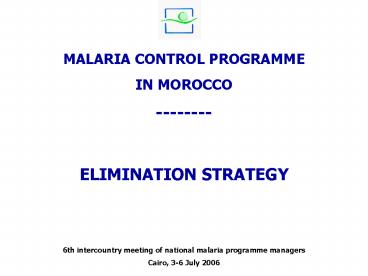MALARIA CONTROL PROGRAMME - PowerPoint PPT Presentation
1 / 20
Title:
MALARIA CONTROL PROGRAMME
Description:
1965 : Starting of control programme: 30.000 cases. 1973 : P.falciparum eradication. 1998 : situation control and adoption of elimination strategy ... – PowerPoint PPT presentation
Number of Views:333
Avg rating:3.0/5.0
Title: MALARIA CONTROL PROGRAMME
1
- MALARIA CONTROL PROGRAMME
- IN MOROCCO
- --------
- ELIMINATION STRATEGY
- 6th intercountry meeting of national malaria
programme managers - Cairo, 3-6 July 2006
2
MALARIA IN MOROCCO History
- 1965 Starting of control programme 30.000
cases - 1973 P.falciparum eradication
- 1998 situation control and adoption of
elimination strategy - 1999-2006Implementation of the elimination
strategy
3
Number of autochtonous malaria cases, Morocco,
1960-1978
4
Number of malaria cases,Morocco, 1980 - 2005
5
Elimination strategy Objectives
- To eliminate autochtonous malaria elimination in
2006 - To control imported malaria
6
Objective 1 To eliminate the autochtonous
malaria by 2006
- Intensification of control actions
- - intensive and focused case detection
(relapsing carriers) - - intensive vector control
- Promotion of intersectoral collaboration
- - control of risk factors
7
Objective 2 To control imported malaria
- Prevention
- - Chemoprophylaxis and advise to
travelers - - Health control at the borders
- Control Early treatment of cases (P.Falciparum)
8
Provinces at malaria risk,Morocco, 2000-2005
Rabat
- Risk factors (criteria)
- - Epidemiologic history
- Presence of the vector
- Population Movement.
9
Elimination strategy Achievements
10
Elimination strategy Achievements
11
Elimination strategy
Epidemiologic situation2002 Last
focus of transmission at Chefchaouen (19 cases)
2003-2005 without local transmission2003 and
2004 Relapsing cases
12
Achivements and progress
- Stopping local transmission
- - Surveillance control activities at high
level - Maintaining of vigilance
- - Annual meetings to discuss the plans of
actions - - Supervisions at the field
- - Reports of provincial committees of vigilance
- Mobilization at the field
- - Extension of the areas at risk
16/1999---31/2004
13
Achivements and progress
- Training and retraining
- Retraining of 15 technicians in microscopy per
year - Training of 10 technicians in microscopy in 2005
(regionalization) - Training of the personnel in charge of resistance
monitoring - Training on imported malaria strategy
- Reinforcement of the surveillance and quality
control - - Implementation of 10 laboratories of quality
control - - Consultation for the evaluation of the
resistance monitoring - Intersectoral collaboration
- - The National Committee of IVM
- International collaboration WHO (1999-2005)
- - Technical (consultations) and financial
14
Constraints
- Resources Reduction
- - Humans
- - budget allocated (nationals and
internationals) - Insufficiency of
- - intersectoral collaboration
- - community participation
- Illegal immigration
15
Elimination strategy Objectives 2007 - 2010
- To maintain stopping of the transmission
- - To reinforce the activities of surveillance
- - To control risk factors
- To control imported malaria
- - Prevention and early treatment of cases
- - Health control at the borders
16
Elimination StrategyMaintain the vigilance
- Training and retraining
- Heighten awareness of the personnel at the field
- Evaluation by provincial comities of vigilance
- To collaborate with the other sectors (IVM)
- Collaboration with WHO
17
Elimination strategy Main activities 2007 - 2010
18
Budget
- National budget
- - Surveillance and routine activities
- (300.000 US / year)
- WHO Budget
- - technical and financial support
19
A document Malaria in Morocco 1920-2006
- Our experience
- Constraints
- Challenges
- Success story
- - etc......Elimination on a good away
20
- Thank you for
- your attention

